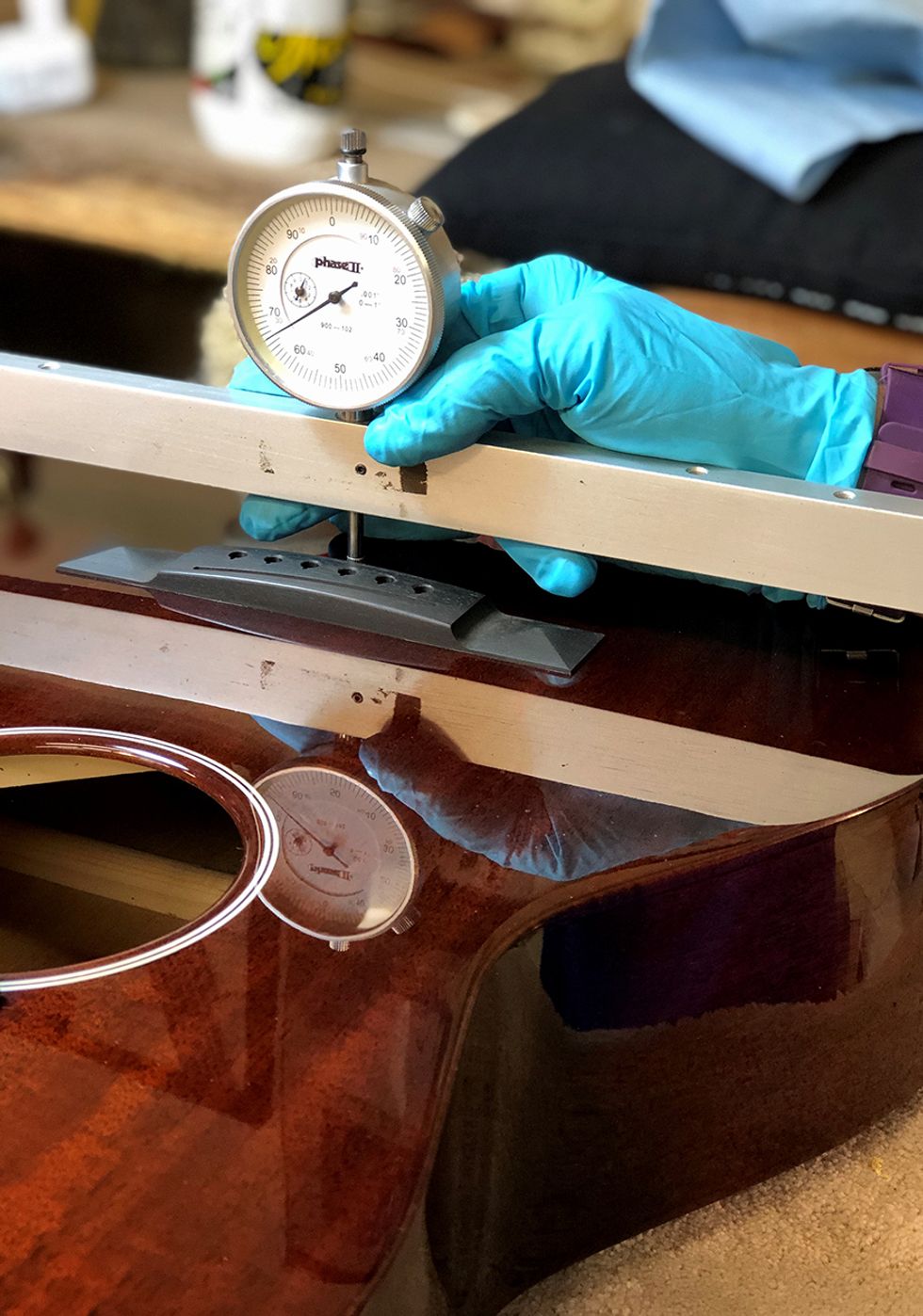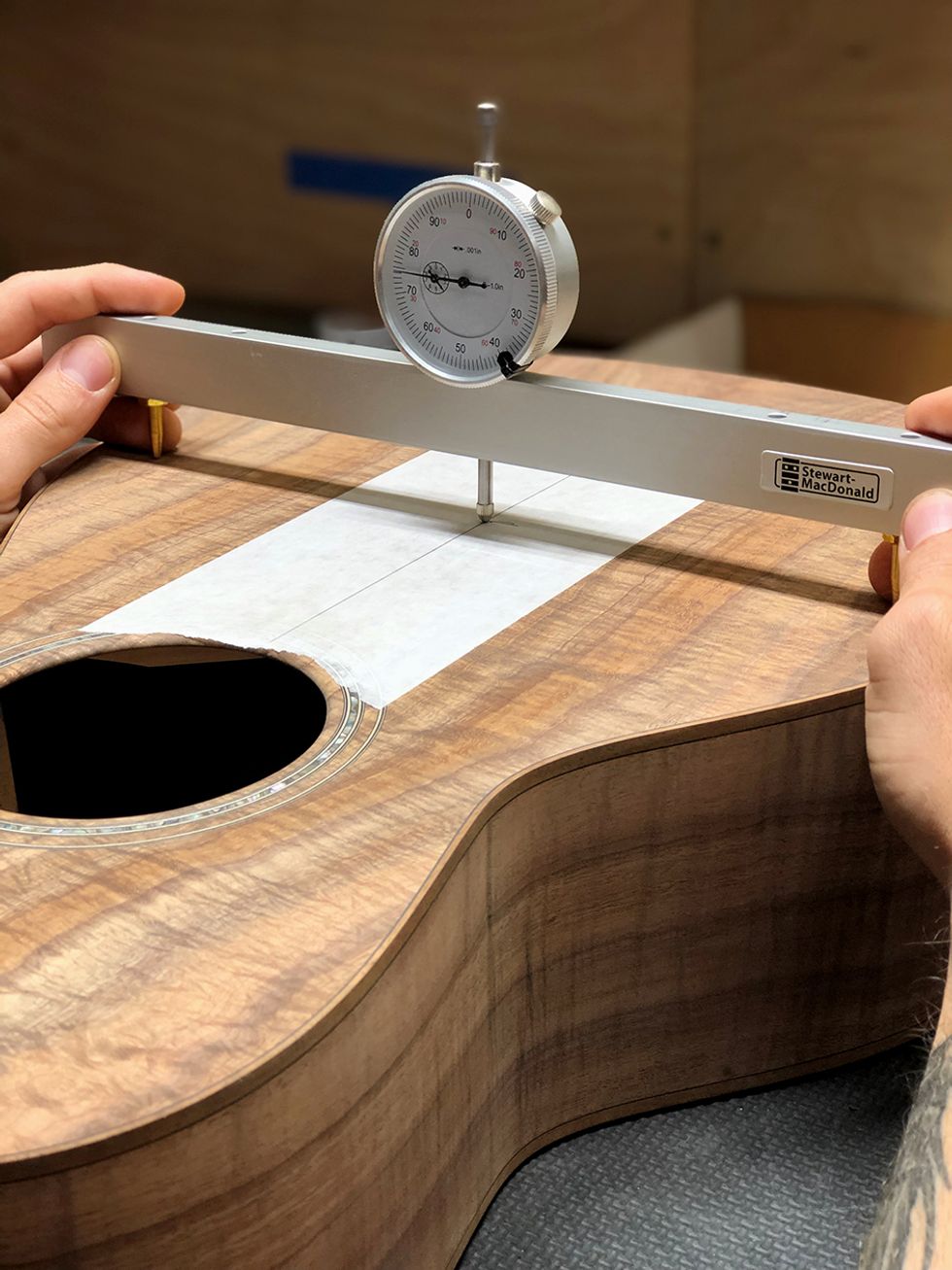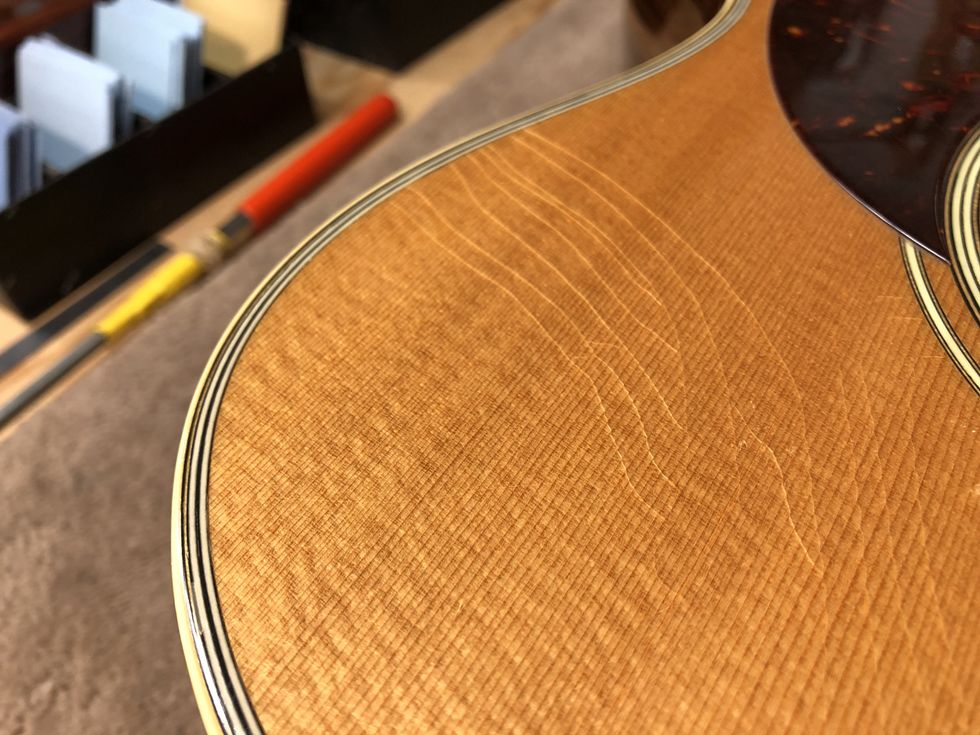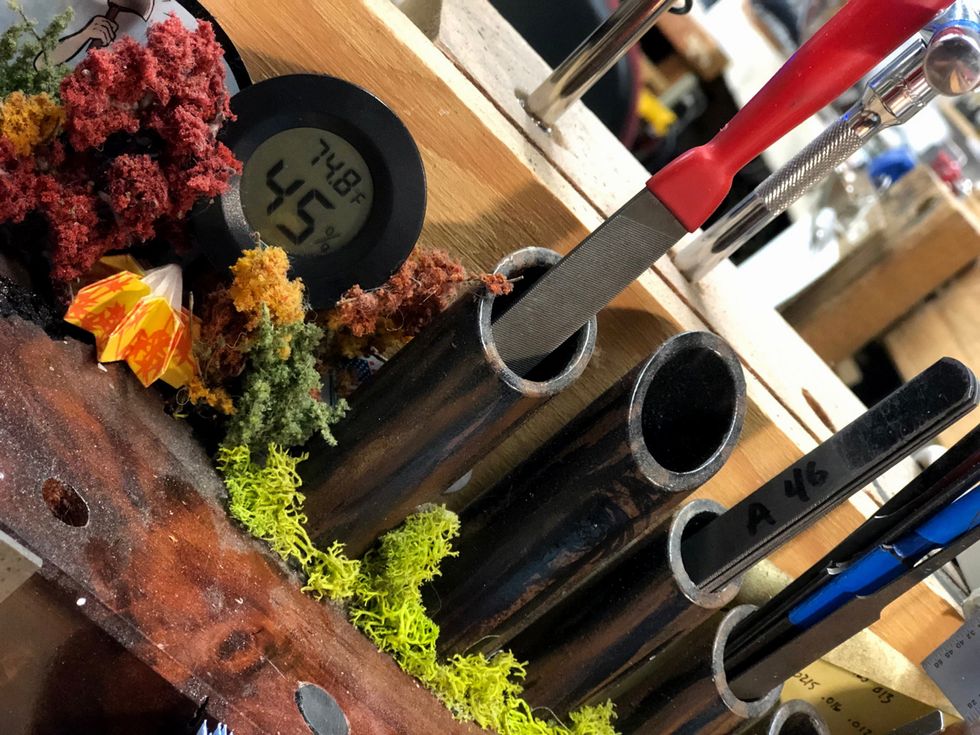Owning any guitar at any price is a blessing. Never dismiss a cheap guitar. Even the humblest model has the potential to change the world through the right song composed at the right time. I speak from experience: I’ll be celebrating my 45th wedding anniversary this year, thanks to my first 1967 Harmony H 150, which I purchased for $40.50. With a tune performed just so, this all-mahogany lunk had the latent potential to turn the head of my darling wife-to-be. That’s the power of an acoustic guitar, and something we should never take for granted. In that spirit, let’s look at what our 6-string companions require in terms of basic TLC.
Resonance Versus Durability
Just like an automobile, which won’t run indefinitely without periodic adjustment for the effects of road conditions, your acoustic guitar requires periodic adjustment to compensate for the effects of extremes in temperature and humidity. At Santa Cruz Guitar Company, we make guitars with the intention that they’ll provide personal fulfillment and joy to their owners throughout their own lives and be passed on to a few succeeding generations of grateful players. This presupposes the instrument will get a modicum of thoughtful care and occasional maintenance. I say “our intention” because the guitars are constructed with restorability inherent in their joinery, glues, and finishes. They’re also built to a carefully calculated recipe that balances lightness for resonance against structural integrity for durability.
The lower your guitar’s initial retail price, the more likely its build is weighted toward durability over resonance. Economy of scale dictates that if a brand makes a million of something a year, they bank on a minuscule percentage being returned for failure in the field. Conversely, SCGC—like many of our colleagues—builds a superbly resonant instrument in a price range we assume will force the player to pay attention to its future well-being by keeping it out of harm’s way and in proper adjustment. So if you got off cheap when buying your guitar, you need to be less concerned about seasonal- and age-related changes because, like patio furniture, your instrument was designed to weather well. If you paid the same for your guitar as for your car, then you should heed the following advice to the letter.
Know Thine Enemies
Dry and wet are dangerous, with dry being the worst. Our tests show that a guitar’s 16" lower bout can shrink as much as 3/8" (10 mm) when going from extremely wet to extremely dry climates. In such conditions, the weakest link in the wood grain will separate. If you laid out in excess of $5,000 for your instrument, you’ll likely see no humor in a top that cracks from dryness. Nor will you appreciate it if the soundboard swells beyond playability from high humidity.
The soundboard’s movement is monitored throughout the build process. Here, top deflection is being tracked. Photo by Richard Hoover
To mitigate such potential weather-related heartbreak, you need to quit suffering the whims of the seasons and instead create your own controlled environment. This can be done in a music room or, more practically, within the case itself. First, invest in a humidity gauge (hygrometer) that you can trust. General Tools offers a wall-hanging, music-room gauge for about $40. That’s a no-brainer. Consider getting a companion to keep in the case, like the Bluetooth-enabled device from Govee (about $80).
Our guitars are built at 47 percent relative humidity (RH) at approximately 72 degrees Fahrenheit. The combination of these two indicators give us the guitar-playing world’s mid-point average for the amount of moisture in the air. This means the instrument can go from Stockholm in the winter (the driest) to Singapore at any season (the wettest) and vice versa, with only half the risk of cracking or swelling, compared to a guitar built in an uncontrolled environment. Most reputable makers practice this kind of control.
Take Charge
Your job is to keep your room or guitar case within parameters that approximate the conditions under which your instrument was assembled. For me, a worry-free zone has temperatures that are comfortable for humans and a RH of 35 to 75 percent.
Fine acoustic guitars are crafted in carefully controlled environments. Even in the earliest stages of a guitar’s construction, the instrument is measured to establish a baseline for wood movement. Photo by Richard Hoover
Once you get a hygrometer, whether it’s mounted on an inside wall or stashed in a closed hardshell case, you’ll need to monitor its readings on a regular basis. Initially, this means checking it several times a day, until you get accustomed to the frequency and range of any variations. And remember: It’s important to position your guitar away from direct sunlight and heat sources, like vents or radiators.
Control the Space
Adding moisture to your environment is not expensive. A room can be brought to spec with a home-style vaporizer, but you’ll want to use utmost care not to over-humidify—especially if the unit doesn’t have an adjustable, built-in humidistat to limit its range. Home HVAC systems can provide or be modified for humidity control, if you can stand the investment. Controlling the environment within the case itself is the surest, least expensive method, if you carefully monitor to avoid too much or too little moisture.
Using technology based on a museum’s need to protect fragile antiquities, D’Addario’s Planet Waves Humidipak is a well-conceived system for use inside a hardshell case. It works to both dry and add moisture. To keep it actively protecting your investment, the Humidipak requires your focused attention to changing the packets, as needed. But if you stay on it, this portable, within-the-case device will keep your guitar happy when on tour or traveling.
When moving a fine acoustic guitar from a freezing outside temperature to a heated building, thermal shock can cause its nitrocellulose finish to crack or check. To avoid this, keep the case closed for a few hours to let the instrument acclimate before pulling it out. Photo by Richard Hoover
If you choose an added-water system, like the Oasis OH-1 or D’Addario Planet Waves Humidifier, you can be sure their designers have taken care to make their products leak-resistant. That said, to keep it working correctly, you’ll need to stay vigilant and monitor the frequency and amount of water needed for refills. Avoid any system that may bring your instrument in direct contact with wetness. It’s much better to strategically place a device per the manufacturer’s recommendation than to indiscriminately toss something into the case.
An important caveat with these types of humidifiers: They only hydrate, they do not dehumidify! Do not use them when your environment is already over your humidity target, as excess humidity can delaminate critical glue joints and warp components critical to playability.
How often you check water level depends on your situation. Our pal Larry Broido, of the late, great Acoustic Roots guitar shop in Philadelphia, found it necessary to put 10 gallons of water per day through his humidifiers to maintain his 2,500 square-foot shop at above 40 percent RH during the driest winter months. So the homemade perforated soap dish with a sponge in it may not emit enough moisture—no matter how often you dunk it. Better to invest in a commercially made device with adequate capacity for your conditions.
Case Closed
As I mentioned earlier, keeping your precious guitar in its case is one of the best ways to limit exposure to rapid temperature changes. But you still have to exercise common sense: When a guitar with a nitrocellulose finish moves from a freezing outside temperature to a heated building, its finish can crack from thermal shock if you open the case suddenly. To avoid this, keep the case closed and move it away from any heat source for a few hours. In other words, let your instrument acclimate before pulling it out.
Within hours, a guitar in a black case in direct sunlight can reach interior temperatures hot enough to re-plasticize glues and cause components to creep. The same horrors can occur in a closed car, which can quickly reach 160 to 180 degrees F on a hot day. If you’re heading into a situation where these conditions are unavoidable, prepare by slackening the strings a half-step, maintaining just enough tension to keep the nut and bridge pins in place. Put the guitar in its case and then cover it with clothes or towels for insulation. Park in the shade and crack the windows, and then deal quickly with whatever distractions caused you to take this risk in the first place.
When your guitar has cooled down from this kind of exposure and you tune it back to pitch, it may take a little time for the neck to return to the same amount of relief that the adjustable truss rod had been set to before you detuned the instrument. Don’t be tempted to adjust the rod or change your action height at this point. Before considering corrective adjustments, give the guitar a day under normal temperature conditions and string tension to return to your default settings.
A digital hygrometer is an essential tool for monitoring the moisture levels in the air, both in the factory and, ultimately, in the future owner’s home. Photo by Richard Hoover
Be Mindful
In review, wet or dry or hot are bad for your acoustic guitar. Wet and hot equals steam, which can turn your guitar into a kit that needs reassembly. Exceedingly dry conditions can cause wood to crack and components to warp. The more expensive the guitar, the more it demands that attention be given to the above precautions. You can find a thoughtful treatise on proper care for your acoustic, as well as how to readjust your guitar to correct for environmental insult, on the Santa Cruz Guitar Company website.
The bottom line: It doesn’t take inordinate work to care for your guitar, but it does require commitment. However, if you make the effort—and modest investment—you’ll be rewarded with an instrument that will play and sound at its best.
















![Rig Rundown: Russian Circles’ Mike Sullivan [2025]](https://www.premierguitar.com/media-library/youtube.jpg?id=62303631&width=1245&height=700&quality=70&coordinates=0%2C0%2C0%2C0)









